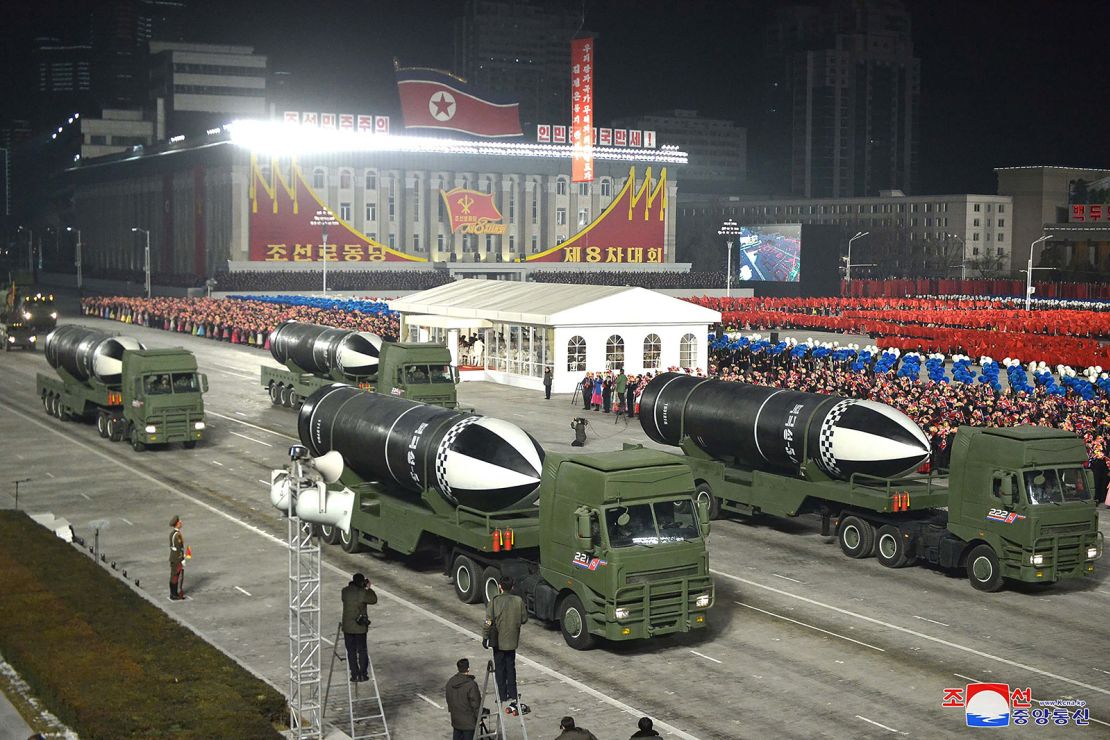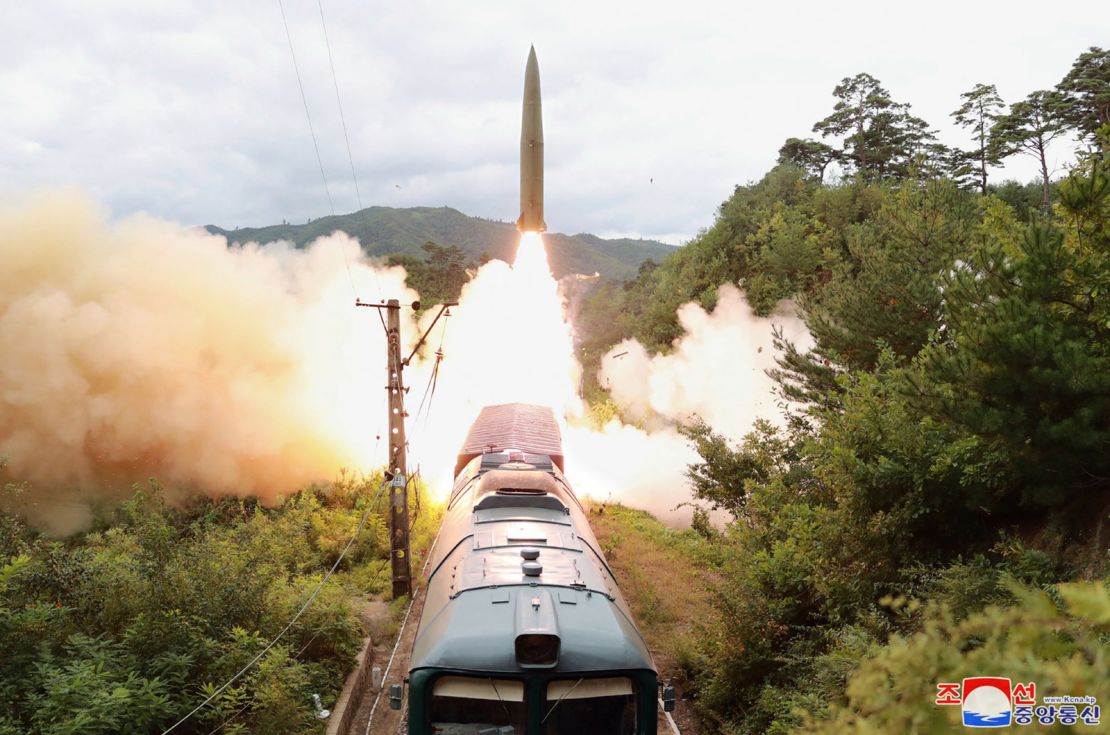The hypersonic missile North Korea claims to have tested on Tuesday has the potential to be one of the world’s fastest and most accurate weapons – and could be fitted with a nuclear warhead, experts say.
While the exact specifications of North Korea’s hypersonic Hwasong-8 missile are not yet known, missiles withhypersonic glide vehiclescan theoretically fly as fast as 20 times the speed of sound and can be very maneuverable in flight, making them almost impossible to shoot down, according to experts.
If North Korea can successfully produce and deploy a hypersonic weapon,analysts say it could even change the military equation in the region.

“If true, it means current South Korean and Japanese missile defense systems become close to impotent,” said Lionel Fatton, an assistant professor at Webster University in Switzerland and researcher at Meiji University in Japan.
Those systems are designed for defense against ballistic missiles, which descend on their targets from much higher altitudes than hypersonics.
“Ahypersonic missile that can defeat advanced missile-defense systems is a game changer if a nuclear warhead is mated to it,” said Drew Thompson, a former US Defense Department official and a visiting senior research fellow at the Lee Kuan Yew School of Public Policy at the National University of Singapore. But he cautioned, “that’s a huge if. Having it and wanting it are not the same thing.”
Pyongyang’s state-run Korean Central News Agency (KCNA) said developing the “strategic” weapon was one of the five “top-priority tasks of the five-year plan” for the country’s defense.
Ankit Panda, a nuclear policy expert at the Carnegie Endownment for International Peace, said on Twitter that North Korea’s use of the term “strategic” in describing the weapon implies a nuclear warhead capability.
North Korea has detonated six nuclear devices and is believed to have a number of nuclear warheads, according to Hans Kristensen and Matt Korda, nuclear experts at the Federation of American Scientists. But they point out there is no certainty that Pyongyang has successfully been able to put a nuclear warhead on a missile and deliver to its target.
The KCNA report said Tuesday’s test was the first for the hypersonic missile, and that it was was successful.
“National defense scientists confirmed the navigational control and stability of the missile in the active section and also its technical specifications including the guiding maneuverability and the gliding flight characteristics of the detached hypersonic gliding warhead,” KCNA said.
Western analysts who looked at the lone picture North Korea released of Tuesday’s test say the weapon had characteristic of a hypersonic boost glide weapon.
After analyzing data from the launch, South Korea’s military said the missile appears to be in early stage development, and it will be some time before it can be deployed.
In a statement sent to reporters, South Korea’s Joint Chief of Staff said the North’s missiles can still be detected and intercepted with South Korean-US military joint assets.
How a hypersonic glide weapon works
Like ballistic missiles, hypersonic glide weapons are launched by rockets high into the atmosphere. But while a ballistic missile warhead is largely powered by gravity once it begins its descent to its target from as high as 1,000 kilometers (621 miles), hypersonics dive back to Earth sooner before flattening out their flight path – flying just tens of kilometers above the ground, according a hypersonics report from the Union of Concerned Scientists.
The weapon then uses internal navigation devices to make course corrections and keep it on target while traveling up to 12 times the speed of sound, the report said.
Roderick Lee, director of research at the American Air University’s China Aerospace Studies Institute, said the lower altitude flight paths of hypersonics mean they stay below radars for longer periods.
“That makes things really complicated for the defender,” Lee added.
Only two countries, Russia and China, are thought to have deployable hypersonic missiles.
In December 2019, Russia said its hypersonic missile system – known as Avangard – had entered service. In a speech to the Russian Parliament in 2018, President Vladimir Putin called the Avangard system “practically invulnerable” to Western air defenses.
In January 2020, Putin oversaw tests of a second hypersonic system, the Kinzhal, off Crimea.
At a 2019 military parade, China showed off its DF-17 missile, which it can use to deploy a hypersonic glide vehicle. A report from the Missile Defense Project at the Center for Strategic and International Studies, citing US defense officials, says the DF-17 can deliver a warhead to within meters of its intended target at a range of up to 2,500 kilometers (1,553 miles).
According to a report this month from the Arms Control Association (ACA) in Washington, DC, the United States is working on eight types of hypersonic weapons. And the military’s Defense Advanced Research Project Agency said this week it had successfully tested a hypersonic weapon in flight a week earlier.
In April, the Pentagon said a US test of a hypersonic missile failed.
The ACA report says hypersonics are contributing to “a burgeoning arms race with all sides rushing the deployment of the new weapons lest they be perceived as falling behind the others in mastery of the new technologies involved.”
Panda, the Carnegie Endowment expert, wrote on Twitter:“Missile proliferation in Asia is happening faster than I can write about missile proliferation in Asia.”
‘A little bombshell’ in North Korean report
While the North Korean weapon’s hypersonic speeds drew top headlines Wednesday morning, missile experts noted something ominous in the KCNA report – “a little bombshell” as Jeffery Lewis, professor The Middlebury Institute of International Studies, wrote in a tweet.
The report said North Korea used a “missile fuel ampoule,” meaning the missiles are fueled in the factory, not after being deployed in the field, Lewis said.

“If the DPRK fuels the missiles in the factory, military units don’t have to spend time doing it in the field when the US Air Force is doing its level best to kill them. … Big step for the DPRK,” Lewis tweeted.
Kim Dong-yub, a professor at the University of North Korean Studies in Seoul, said the fuel ampoule can prolong the time missiles can spend deployed, waiting for launch.
“It seems that North Korea is trying to overcome the disadvantages of pre-launch injection of liquid fuel,” which has been the predominant fuel in North Korean missiles, he added.
US military officials said Tuesday’s launch did not pose “an immediate threat to US personnel or territory, or to our allies” butit did highlight “the destabilizing impact of (North Korea’s) illicit weapons program.”
Pyongyang is barred from testing ballistic missiles and nuclear weapons under international law. Previous such tests have been met with international opprobrium and sanctions from the United Nations Security Council.
North Korea ramps up testing
The missile test was North Korea’s third this month.
In the first, Pyongyang said it tested long-range cruise missiles over two days, on September 11 and 12. Then, on September 16, both North and South Korea tested ballistic missiles – ratcheting up tensions exponentially in what was already one of the most volatile regions on the planet.

On Tuesday, news of the North Korean test came just before Pyongyang’s representative to the United Nations, Kim Song, addressed the UN General Assembly in New York, where he lamented the divide between North and South Korea and criticized the US presence in the region.
Kim accused the US of “antagonizing” his country with military exercises in the region, saying Pyongyang would be “prepared to respond willingly at any time” to friendly overtures from Washington.
In the meantime, he said, “as the whole world knows, and as the US is so much concerned, powerful offensive means are, of course, included in our war deterrent.”
Whether a hypersonic missile will be part of that North Korean deterrent remains to be seen.
“If they can develop a reliable nuclear warhead that is small enough to be delivered by a missile, and they can conduct tests of the warhead and missile, then they have demonstrated that they have credible capability,” said Thompson, the Singapore researcher.
For now, he’s skeptical.
“(A) North Korean hypersonic system strikes me as fantasy at this point,” Thompson said.
But Leif-Eric Easley, a professor at Ewha University in Seoul, said Pyongyang’s hypersonic missile may not need to be as accurate as those potentially deployed by other nations.
“If Pyongyang manages to fit a nuclear warhead on even a rudimentary hypersonic, it would be a dangerous weapon because it wouldn’t have to be extremely accurate to threaten the nearby metropolis of Seoul,” he said.
CNN’s Yoonjung Seo and Gawon Bae contributed to this report.
























